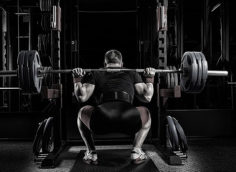Nothing's more emblematic of a broken-down lifter than the overuse of external training crutches like wraps, sleeves, belts, and other accessories designed to hold together body parts that most likely lack ligamentous and capsular stability.
Sure, the use of knee wraps can be a viable option for adding poundage to your squats and presses by adding a more elastic component to the bottom of your range of motion. So functionally, yes, wraps work and work very well. But what about from a long term joint and soft-tissue health perspective?
The long term use of wraps for an extended number of sets per training day can add some unwanted shear and compressive forces to local joints. Let's be clear here, this won't be likely to happen after just a few sets, but it will happen over time if all of your sets are compressed.
If you're using incomplete ranges of motion with wraps, your best bet is to normalize your ranges, not wrap tighter. The use of wraps and sleeves can be viewed as a metaphor for your entire life. If you depend on crutches, it's just a matter of time until you fall on your ass and can't get up.
The use of a lifting belt is justifiable for strength and physique athletes that know how to properly brace and utilize the belt during strategic sets while using maximal loads or insane intensities. Notice I didn't say anything about newbies trying to falsely inflate their already pitiful numbers, or having a convenient place to clip their phone.

During some of the big movements like the squat and deadlift, the use of a belt almost becomes a requirement if you want to maximize your iron performance. No qualms with that. When used strategically, it's a great tool.
But we have to draw the line when the lifting belt becomes a necessary crutch for just about every single movement, including arm training and the elliptical! Yes, yes, the belt strapped around your lumbar spine makes you feel stable, but isn't that feeling of instability telling you something?
Take the belt off and assess your true baseline of function. Only then will you objectively be able to evaluate your weak links, improve the chinks in your armor, and then implement the belt correctly.
Don't become the "compression man" where every set is highly dependent on wraps, belts, and other dependencies. If your goal is to keep on lifting for life, limit your external fixes and start improving your internal stability, mobility, and motor control factors. You'll thank me when you're 70 and still hitting the gym hard.





